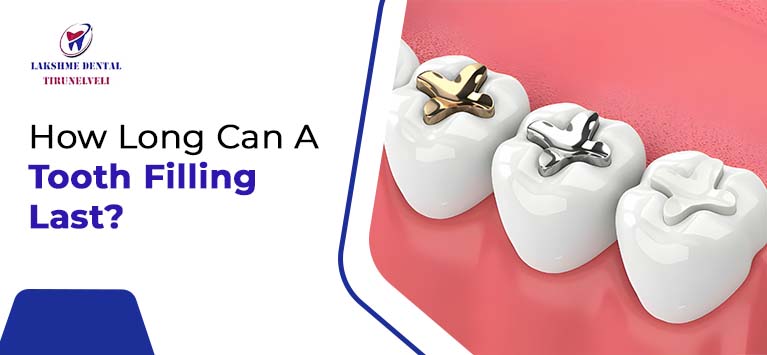
How Long Can A Tooth Filling Last?
Are you wondering about the lifespan of your tooth filling? A tooth filling is a common dental procedure used to restore teeth damaged by decay or trauma. But the question is, how long can you expect it to last? In this informative guide, we’ll talk about the longevity of a tooth filling. We will also cover types of tooth fillings and the factors that determine the longevity of tooth fillings. Further, this blog will provide valuable insights to help you maintain a healthy smile. So, now we will explore the durability of tooth fillings and understand how to maximize their lifespan together.
Understanding Tooth Fillings
Tooth fillings are dental restorations used to repair cavities caused by decay or fractures in teeth. They are comprised of hard substances like gold, silver, or ceramic. The goal is to fix decayed or damaged teeth by filling in cavity holes caused by the damage. However, it’s essential to note that dental fillings typically cannot fully restore teeth to their original condition following damage. But they help restore the tooth’s shape, function, and strength while preventing further decay.
What is the Need for a Tooth Filling?
Tooth fillings serve a crucial role in dental care by addressing various issues. Otherwise, the problems can compromise the health and integrity of your teeth. Here’s why tooth fillings are necessary:
Restoring Tooth Structure
When a tooth develops a cavity due to decay, a filling is used to restore its structure and prevent further damage. Without a filling, the cavity can continue to grow, eventually leading to more extensive dental problems.
Preventing Decay Progression
Fillings seal off the cavity, preventing bacteria and food particles from accumulating within the tooth and causing further decay. This helps halt the progression of decay and preserves the remaining healthy tooth structure.
Enhancing Tooth Functionality
A tooth with a cavity may experience sensitivity or pain, especially when chewing. By filling the cavity, the tooth’s functionality is restored, allowing for normal biting and chewing without discomfort.
Protecting Against Fractures
Teeth weakened by decay are more susceptible to fractures or cracks. Fillings provide reinforcement to the tooth structure. Likewise, they reduce the risk of fractures and preserve the tooth’s integrity.
Improving Aesthetics
In addition, tooth fillings can also improve the appearance of damaged or discolored teeth. Modern filling materials, such as composite resin, can be matched to the natural color of your teeth. Besides, they provide a seamless and aesthetically pleasing result.
Preventing Tooth Loss
Left untreated, decay can progress to the point where the tooth becomes irreparably damaged and may need to be extracted. By promptly addressing cavities with fillings, the need for tooth extraction can be avoided, preserving your natural smile.
In essence, tooth fillings play a vital role in maintaining oral health. If you suspect you may need a filling, don’t hesitate to make an appointment with your healthcare professional.
Types of Tooth Fillings
There are several types of tooth fillings available, each with its own unique characteristics and longevity. Common types include:
Amalgam Fillings
Made from a mixture of metals, including silver, tin, mercury, and copper, amalgam fillings are renowned for their robustness and lasting quality. However, they can be also associated with issues such as marginal leakage and secondary caries.
Composite Fillings
Made from a combination of glass materials and plastic. They blend with the natural color of teeth but may not be as durable as amalgam fillings.
Gold Fillings
Made from gold alloy. These fillings are highly durable but less commonly used due to their noticeable appearance and cost.
Ceramic Fillings
Made from porcelain. These are tooth-colored and offer excellent aesthetics but may be prone to chipping.
Understanding the filling used can provide insights into its potential lifespan.
Factors Influencing the Longevity of Tooth Fillings
Various factors can influence how long a tooth filling lasts. Here are some key determinants:
Type of Filling Material
Different filling materials have varying levels of durability. Amalgam fillings tend to be the most durable, followed by gold fillings. Ceramic fillings may have a shorter lifespan in comparison. Recent technological advancements and innovations have significantly enhanced the strength and durability of composite fillings.
Size and Location of the Filling
The size and location of the filling play a significant role in its longevity. Fillings in areas subjected to heavy chewing forces, such as molars, may experience more wear and tear and may need to be replaced sooner.
Oral Hygiene Practices
Maintaining good oral hygiene habits, including regular brushing, flossing, and dental check-ups, can help prolong the lifespan of tooth fillings. Poor oral hygiene can contribute to recurring decay near the filling, which may weaken its structure.
Diet and Lifestyle Factors
Dietary habits, such as consuming sugary foods and drinks, can contribute to the deterioration of tooth fillings. Additionally, habits like teeth grinding (bruxism) can put excessive pressure on fillings, leading to premature failure.
Dental Care and Maintenance
Regular dental visits for professional cleanings and check-ups are essential for monitoring the condition of tooth fillings. Your dentist can detect any signs of deterioration early on and recommend appropriate treatment.
These factors can help you take proactive steps to prolong the lifespan of your tooth fillings.
Signs of Failing Tooth Fillings
It’s crucial to be aware of the signs indicating that a tooth filling may be failing. Look out for:
- Sensitivity or pain when biting or chewing
- Visible cracks or damage to the filling
- Discoloration or staining around the filling
- Rough edges or a noticeable gap between the filling and tooth
If you notice any of these symptoms, it’s important to schedule an appointment with your dentist promptly. They will do an evaluation and provide a potential replacement for the filling.
Maximizing the Lifespan of Tooth Fillings: Tips for Maintenance
To extend the lifespan of your tooth fillings, consider implementing the following tips:
- Limit consumption of sugary foods and drinks to reduce the risk of decay.
- Steer clear of using your teeth to open packages or bite into hard objects.
- Wear a mouthguard if you grind your teeth (bruxism) to prevent damage to fillings.
- Schedule cleanings and dental check-ups from time to time to monitor the condition of your fillings.
- Keep up with proper oral hygiene habits, such as brushing your teeth twice a day and flossing regularly.
Incorporate these maintenance tips into your oral care routine. With this, you can prolong the lifespan of your tooth fillings and enjoy a healthier smile for years to come.
Closing Thoughts
The longevity of a tooth filling depends on various factors, including the filling material, size, and location of the filling, oral hygiene practices, diet, lifestyle factors, and dental care. By understanding these factors and adopting proper maintenance strategies, you can maximize the lifespan of your tooth fillings and maintain a healthy smile for years to come. If you have any concerns about tooth fillings, don’t hesitate to consult us for advice and assistance.










